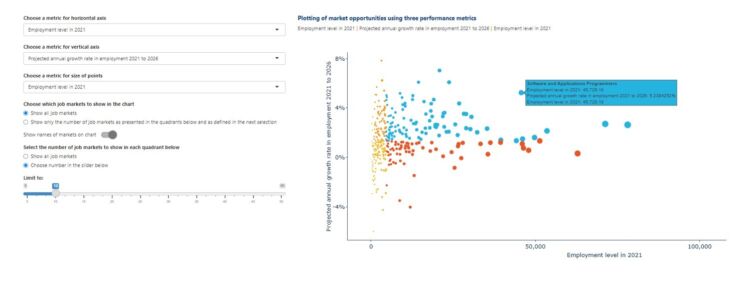Idea In Brief
Use data
In a university, the strategic marketing function can serve as a conduit between the market (industry and students) and academics who lead or influence course development – if the marketing team has the tools at hand.
Create a great CX
Universities are investing to give prospective students a seamless start to their student life. But the experience of students once they are in the door can be inconsistent if not underpinned by a sophisticated CX function.
Deploy automation
Today’s students demand a mix of in-person and digital course offers. Marketing can enable the university to decide about digital offers and can support recruitment, admissions and other functions.
“Treat your brand as an asset, not an expense, on your balance sheet.”
That sage advice has long guided the thinking of the most successful customer-facing businesses – and we think there is much that universities can learn from it too.
The message implores organisations to invest in brand and marketing activity rather than treating it as a necessary expense.
In our work with universities internationally we have seen that while many institutions have built sophisticated brand and marketing functions, they have struggled to unite brand, marketing, recruitment (sales) and core university business.
This article explores the ways universities can capitalise on their marketing investment.
Australian universities face headwinds in student markets
Australian universities have experienced more than 20 years of sustained growth in international student numbers. Strong brands, reputations and rankings have allowed this persistent increase in student volume. But the pandemic has taught us the growth in domestic and international student markets we saw pre-COVID isn’t guaranteed.
Australian universities know they must woo international students from India and Southeast Asia, given heavy reliance on students from China leaves Australian universities hostage to international political fortunes.
When it comes to growth in Australia’s domestic student market, demographic changes, an uncertain funding environment and rapidly evolving labour market conditions create challenges.
Essential to rising to these challenges is investing in marketing and its associated functions of recruitment and admissions. We have identified three priorities for universities in this domain:
- Build sophisticated data capability to understand the drivers of demand.
- Facilitate a seamless and personalised customer experience.
- Use digitisation and automation to expedite processes, manage relationships and expand product offers.
We have drawn on our experience working with universities to sketch out what action on these priorities might look like.
Build sophisticated data capability to understand the drivers of demand
The global economy is in flux. Unemployment is low and there are nation-wide skills shortages in critical industries. We need a workforce able to respond to economic and industry changes. Evidence of what kinds of workers are needed, and how many, is vital for knowing what courses we need in order to prepare current and future workers. Similarly, data on what and how students want to learn should influence the way universities structure their course offers.
In a university, the strategic marketing function can serve as a conduit between the market (industry and students) and academics who lead or influence course development – if the marketing team has the tools at hand.
Though our partnerships with two valuable data providers – Lightcast (formerly Burning Glass), which captures granular data on skill needs in the labour market, and Studyportals, which captures data on search trends for prospective students – we can provide real-time information about industry need and student behaviour.
When coupled with effective learning design, this intelligence can equip universities to deliver in-demand courses and subjects and to pare back or rebrand low-demand courses. This can allow universities to optimise marketing spend and hit recruitment targets.
Nous’ Data Insights for Market Analysis (DIMA) brings both these data sets together and provides our clients with easy access to detailed data insights and visualisations.
We have worked closely with one of Australia’s largest universities to set up a Market Insights Dashboard and embed its use at the university. We worked collaboratively to tailor the data sets and provide analysis and visualisations to meet the client’s requirements. We then supported adoption by instructing core users on best use and developing a training guide.
The result is a tool that is owned and managed by the marketing team but supports academics and learning designers across the institution to identify and develop course opportunities.
You can see a sample image from DIMA here:

Facilitate a seamless and personalised customer experience
Universities are investing heavily in attraction, recruitment and admissions functions to give prospective students a seamless start to their student life. But the experience of students once they are in the door can be inconsistent if not underpinned by a sophisticated customer experience (CX) function that starts at attraction of the prospective student.
The challenge can arise from an inconsistent view across a university of what a good student experience looks like and from a lack of systems and processes to support the various touchpoints along the student journey.
Our recent study, “From promise to pragmatism: Delivering a better student experience”, reinforces this point, finding that students don’t see their academic experience as separate from student support services or student life, but as elements of the one package.
CX needs to exist across the value chain, from attraction to graduation and beyond, and it needs to measure, and provide insights about, everything from student life to course satisfaction and the evolving needs of the market. Beyond improving student experience and retention, CX can build a pipeline of alumni more likely to return for further study or engage in partnerships or philanthropy.
Of course, students are not the only customer of a contemporary university. CX can also improve the experience of other customers – say, the industry expert who supports project-based learning, the regional vocational education provider who shares lab space, and the sessional academic who delivers a sell-out course.
Marketing can give professional and academic staff the insights and knowledge required for a personalised and customer-centric approach.
Nous has worked with university marketing teams to establish a CX function or adopt a CX approach that uses data, customer research and human-centred design to support the university.
For example, Nous worked with a leading Group of Eight university to develop an innovative approach to developing student personas to help the university understand the needs and nuances of its diverse student population. The personas were informed by deep qualitative research with students and sophisticated cluster analysis of anonymised student data.
The personas are now embedded in the CX function and broader university work. They are used to develop new content and pathways on the website and student portal and are regularly consulted when designing new services, enhancing service models and onboarding new staff.
Use digitisation and automation to expedite processes, manage relationships and expand product offers
Advances in technology – such as robotic process automation (RPA) and optical character recognition (OCR) – can expedite manual tasks, especially in admissions. While the quality of applications in the admissions process should always be assessed, automation for conditional offers can reduce turnaround time and allow effort to be focused elsewhere.
This has the benefit of capturing students at a critical point in their decision-making process – it can mean the difference between the conversion or loss of a prospective student, simply based on which university responds first.
Further, use of customer relationship management (CRM) systems to their full potential can improve student engagement and management of research partners and industry investors who may have numerous touchpoints across the university. Better-managed relationships can grow partnerships and related revenue while reducing the burden on staff.
Today’s students demand a mix of in-person and digital course offers and features. Knowing what to digitise and how requires data and insight-driven learning design. Marketing can enable the university to decide about digital offers and can support recruitment, admissions and other functions with automation and customer engagement.
Nous has worked extensively with universities to adopt a digital strategy in which key functions and activities are led by sophisticated marketing teams in concert with their university ICT peers.
In our recent experience at a sector leader in university student recruitment, Nous worked closely with the admissions team and internal solutions function to identify, scope and prioritise significant opportunities to automate admissions and enrolments processes.
The result was a seamless enrolment experience for students and less manual work for the admissions team. This joined-up approach is essential to the modern university, given the intrinsic link between technologies and customer needs and expectations.
The marketing team can be a competitive advantage as universities face a challenging market
The contemporary university invests in and aligns its brand, marketing, recruitment and admissions functions to provide sophisticated data and insights for decision-making and to enhance the customer experience across all facets of education and research.
Failure to recognise the value of the marketing team can leave universities with a shrinking market share and disengaged students, staff and partners. The best universities are treating their marketing team as an asset rather than as an expense.
Get in touch to discuss how we can support your university marketing team to have real impact.
Connect with Christine Samy and Nick Lovelock on LinkedIn.
Prepared with input from David Diviny and Nathalie Swainston.



